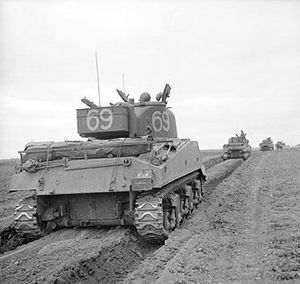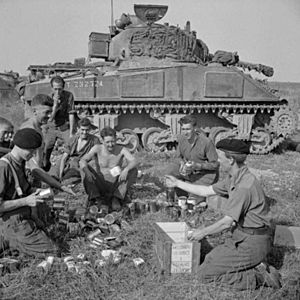Northamptonshire Yeomanry facts for kids
Quick facts for kids Northamptonshire Yeomanry |
|
|---|---|

Badge and service cap as worn at the outbreak of World War II
|
|
| Active | 1794–1971 |
| Country | |
| Branch | |
| Type | Yeomanry |
| Size | World War I Three Regiments World War II Two Regiments |
| Engagements | World War I First Battle of Ypres Battle of Neuve Chapelle Second Battle of Artois World War II Operation Overlord Operation Charnwood Operation Totalize Operation Varsity |
The Northamptonshire Yeomanry was a special cavalry group in the British Army. It started in 1794 as a volunteer cavalry unit. This group served in important wars like the Second Boer War, the First World War, and the Second World War. In 1956, it became a smaller unit. The Northamptonshire Yeomanry stopped existing on its own in 1971.
Contents
History of the Yeomanry
How it Started
In 1793, the leader of the British government, William Pitt the Younger, had an idea. He suggested that counties in England should create volunteer cavalry groups. These groups, called Yeoman Cavalry, could help the king defend the country. They could also help local leaders keep peace if there was trouble.
The Northamptonshire Yeomanry Cavalry first formed in 1794. But it was later closed down in 1828. It started up again in 1830 as smaller, independent groups. However, it was disbanded once more in 1873.
Fighting in the Boer War
A new group, the Northamptonshire Imperial Yeomanry, was created during the Second Boer War. This war took place in South Africa. The regiment was based in Northampton at a place called Clare Street drill hall.
The First World War (1914-1918)
Before the First World War, a law was passed in 1907. This law created the Territorial Force. This force was meant to defend Britain at home during wartime. Its members did not have to fight outside the country.
But when the war began in August 1914, many members chose to serve overseas. So, the Territorial Force units were split. They formed "1st Line" units for overseas service. "2nd Line" units were for home service. Later, a "3rd Line" was created. This group trained new soldiers to replace those fighting.
1st Northamptonshire Yeomanry
When the war started in August 1914, the 1st Line regiment joined the Eastern Mounted Brigade. This brigade was part of the 1st Mounted Division.
In November 1914, the regiment moved to France. It joined the 8th Division. In April 1915, the regiment was split up. Different parts joined different divisions. For example, some joined the 6th Division.
In May 1916, the regiment came back together. It became the cavalry regiment for the 6th Corps. In November 1917, it moved to Italy. There, it became the cavalry for the 14th Corps.
2nd Northamptonshire Yeomanry
The 2nd Line regiment was formed in September 1914. In November 1915, it joined the 59th (2nd North Midland) Division. In April 1916, this regiment also began to split up.
Some parts joined the 69th (2nd East Anglian) Division in Yorkshire. Another part joined the 67th (2nd Home Counties) Division in Kent. Later, a squadron went to France. It became part of the Tank Corps in 1917. The remaining squadrons in the UK were either absorbed into other units or disbanded.
3rd Northamptonshire Yeomanry
The 3rd Line regiment was formed in 1915. It was linked to the 3rd Reserve Cavalry Regiment in Canterbury. In early 1917, it joined the 6th Reserve Cavalry Regiment at Tidworth.
Between the World Wars
After the First World War, the regiment was reformed on February 7, 1920. It was part of the Territorial Army. Its main office was in Northampton.
After the war, it was decided that only a few cavalry regiments would keep their horses. Most others would change roles. So, in 1922, the Northamptonshire Yeomanry became the 7th (Northamptonshire) Armoured Car Company, Tank Corps. This meant they used armored cars instead of horses.
It changed names a few times. In 1922, it became the 25th (Northamptonshire Yeomanry) Armoured Car Company, Tank Corps. In 1923, it was called the 25th (Northamptonshire Yeomanry) Armoured Car Company, Royal Tank Corps. In 1939, it joined the Royal Armoured Corps.
In 1938, a new Mechanised Cavalry Brigade was planned. The Northamptonshire Yeomanry was chosen to be part of it. It was told to grow into a full regiment. By 1939, its main office and "A" Squadron were in Northampton. "B" Squadron was in Daventry, and "C" Squadron was in Brackley.
Around this time, the Territorial Army decided to create duplicate units. This was because a new war in Europe seemed likely. So, in May 1939, the Northamptonshire Yeomanry split into two regiments:
- 1st Northamptonshire Yeomanry (TA)
- 2nd Northamptonshire Yeomanry (TA)
Both regiments were part of the 20th Light Armoured Brigade. They were ready for war on September 1, 1939. A "4th NY" was also formed later as a special unit.
The Second World War (1939-1945)
1st Northamptonshire Yeomanry
In 1944, the 1st Northamptonshire Yeomanry was part of the 33rd Armoured Brigade. They took part in the Invasion of Normandy. They landed on Gold Beach in Normandy on June 6. Their job was to support the infantry (foot soldiers).
One important battle they fought was at Le Mesnil-Patry on June 11, 1944. They were also involved in battles around Caen. This included Operation Charnwood on July 7, which was a fight to capture Caen. On July 16, 1944, they were part of Operation Pomegranate.
On August 8, 1944, they fought in Operation Totalize. This was a plan to break out from the Caen area. During this operation, a Sherman tank gunner named Joe Ekins from the Northamptonshire Yeomanry became famous. He is believed to have killed a very well-known German tank commander, Michael Wittmann. This happened near Saint-Aignan-de-Cramesnil, France.
The regiment later joined the 51st (Highland) Infantry Division for a short time. This was during the actions around the Battle of the Bulge. The regiment then got new equipment. They used LVT 4 Buffalo vehicles. These were amphibious vehicles that could travel on land and water. They were used for Operation Plunder, which was the crossing of the Rhine River. The regiment was then under the command of the 79th Armoured Division.
2nd Northamptonshire Yeomanry
In 1943, the 2nd Northamptonshire Yeomanry left the 20th Armoured Brigade. It became an Armoured Reconnaissance Regiment. This means they were used for scouting and finding out about the enemy. They joined the 11th Armoured Division.
The regiment landed in Normandy in June 1944. But in August, it was disbanded. Its members were sent to other regiments.
4th Northamptonshire Yeomanry
The 4th "regiment" was a special unit. It was formed to trick the enemy. They built and moved dummy tanks. This made the enemy think the British had more tanks than they actually did. It also made them think the tanks were in different places.
After the Wars
The 1st and 2nd Northamptonshire Yeomanry were both officially closed down by 1946. But they were brought back together on January 1, 1947. They reformed as The Northamptonshire Yeomanry, RAC (TA).
In 1956, the Territorial Army changed again. The regiment became a single squadron. It was called "D" (Northamptonshire Yeomanry) Squadron. This squadron was part of the Inns of Court Regiment. This lasted until April 1961. Then, "D" Squadron moved to the Royal Engineers. It became the 250th (Northamptonshire Yeomanry) Independent Field Squadron, RE (TA).
In April 1967, the Territorial Army changed its name to the Territorial & Army Volunteer Reserve. The Northamptonshire Yeomanry continued its traditions as "A" (Northamptonshire Yeomanry) Company, The Northamptonshire Regiment Territorials. In 1969, the Northamptonshire Yeomanry was reduced to a very small group. Finally, in 1971, this small group became part of the Royal Anglian Regiment. This meant the Northamptonshire Yeomanry no longer existed as a separate unit.
Uniforms and Badges
When the regiment was established in February 1902, they received the new khaki uniform. This uniform was being given to the whole British Army. The Northamptonshire Yeomanry had special details on their uniform. These included light blue ("cornflower") facings and piping. Their cap and collar badge showed a galloping white horse. This horse design had been used by earlier Northamptonshire Yeomanry groups in the 1830s and 1840s.
By 1905, officers had a more fancy dark blue uniform for special events. It was in the style of a dragoon (a type of cavalry soldier). They wore a white-metal helmet with a plume (feathers). The braiding on their tunics and their belts were silver. The regular soldiers wore simpler blue uniforms for parades and walking out. All ranks kept the cornflower blue color on their uniforms.
See also
- Imperial Yeomanry
- List of Yeomanry Regiments 1908
- Yeomanry
- Yeomanry order of precedence
- British yeomanry during the First World War
- Second line yeomanry regiments of the British Army



